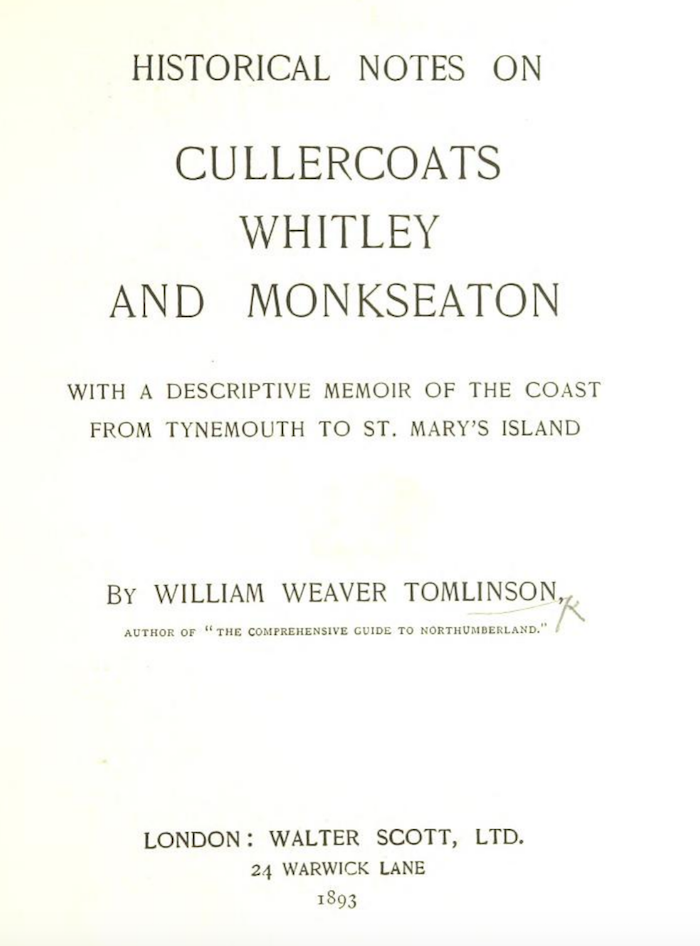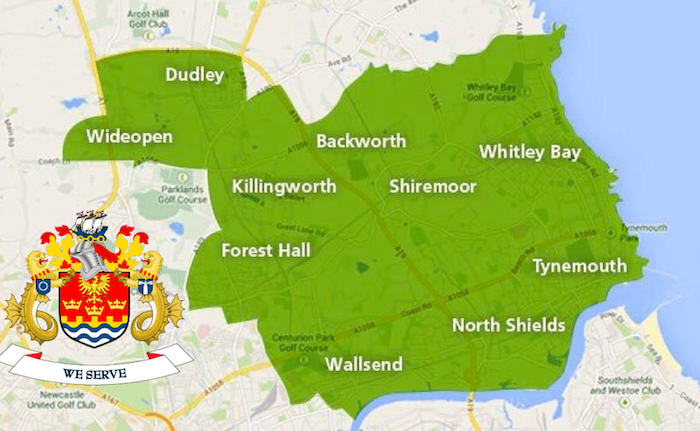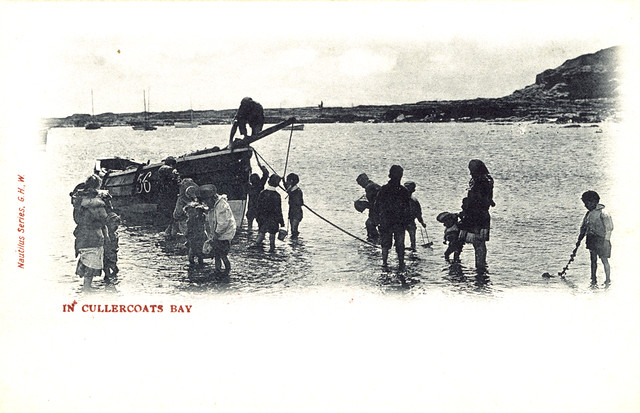Topics > Tyne and Wear > North Tyneside > Cullercoats > Historical Notes on Cullercoats, Whitley and Monkseaton (1893)
Historical Notes on Cullercoats, Whitley and Monkseaton (1893)
Extracts from: "Historical Notes on Cullercoats, Whitley and Monkseaton. With a descriptive memoir of the coast from Tynemouth to St. Mary's Island" William Weaver TOMLINSON, London, 1893.
THE village of Cullercoats is not quite three centuries old. It is doubtful whether such a place existed at the end of the sixteenth century. Cullercoats does not appear in Speede's map of Northumberland, which was published in 1610, though Whitley, Monkseaton, Hartley, Earsdon, and other villages in the neighbourhood are duly indicated. Even as late as 1654 the place was of so little importance that it is omitted from Hollar's map of the Tyne, engraved for Ralph Gardner's England's Grievance Discovered in Relation to the Coal Trade.
What is now Cullercoats formed part of the extensive possessions of the Priory of Tynemouth. We are not warranted, however, in assuming, on etymological grounds, that it was here where the monks had their "culver-house" or "columbarium." It hardly seems likely they would keep their pigeon sat such a distance from the larder. As a matter of fact, we know that there were dove-cotes within the precincts of the monastery.
On the suppression of the larger religious houses in 1539 the possessions of the Priory were seized by the Crown.
In 1588 we find that Peter Delaval, cloth-worker and citizen of London, and Ralph Delaval, gentleman, purchased the rectory and advowson of Tynemouth, with the buildings and glebe-lands, etc., pertaining to it, from Downing and Dodding, to whom Queen Elizabeth had granted them a few months before.
With these brothers, scions of a great and historic family, we may fitly begin our account of the history of Cullercoats.
Ralph Delaval, in the year 1606, made a confirmation or surrender of lands at Cullercoats ("Culler Corners" it is called in the deed) to his brother, Peter Delaval. The place was known at this time as "Arnold's Close, alias Mardon Close," which is said to be situated "within the field and territory of Tynemouth." The boundaries of this close were precisely those of the present manor and township of Cullercoats.
Who this Arnold was who gave his name to the property we have no means of ascertaining. There were several persons of the name in Newcastle about the middle of the sixteenth century, one of them, James Arnold, being appointed an alderman of the Trinity House in 1547.
In 1618 "Arnold's Close" was in the hands of John Delaval, of Tynemouth. In this year he granted it in fee to a person of the name of Thomas Wrangham.
Three years later, in 1621, this Thomas Wrangham and Catherine, his wife, disposed of the estate to Thomas Dove, of Whitley, whose descendants, for nearly a century, were destined to have so much to do with the growth and prosperity of Cullercoats.
We first meet with this local family about the year 1539, when,inthe Ministers' Accounts for the Demesne Lands, etc., of the Priory of Tynemouth, it is stated that a wind-mill called Tinmouth Mill, and a water-mill called Mardon Mill (the latter, as will be seen later, situated at Cullercoats), were in the tenure of Robert Dove and John Dove at the yearly rent of £9 0s. 8d. A Christopher Dove, who died at Tynemouth in the year 1589, bequeathed three oxen and a nag to his nephew Robert Dove, of Monkseaton, the father probably of the Thomas Dove who purchased Arnold's Close in 1621.
On the 4th of May 20 Charles I. (1644), Thomas Dove, of Whitley, granted to Richard Simpson, miller, at a yearly rental of ios., a lease for 99 years of "one parcell of ground to build an house upon, containing 10 yards in length and 7 yards in breadth, together with a parcel of ground lying on the south and east sides of this housestead, boundering on the north on Mardon Mill, and on the south and east sides on certain houses belonging to Thomas Dove, one in the possession of John Nicholson, another in that of Thomas Skelton, and a third, to the eastward, in the possession of Cuthbert Haswill, and boundering on the north-east side to the full sea-mark, all which said parcell of ground and premises are part of the freehold called Arnold's Close, belonging to Thomas Dove."
Liberty was also granted to Richard Simpson " to fish with one boat to be builded, repaired, and managed" at the equal charge of Thomas Dove and himself.
Thomas Dove was one of the Tynemouth Four-and-Twenty in 1645, but we may infer that either his allegiance to the Established Church had been shaken, a few years later, by the theological controversies of the time, or that he had considerable sympathy with the Nonconformists, from the fact of his enclosing, about 1661, a small piece of ground in "Arnold's Close" as a burying-place for such members of his family and friends as were Independents or Quakers. The first person interred int his burying-place was Joanna, daughter of George Linton, who died on the 20thNovember 1661. George Linton himself no doubt intended to find here his last resting-place, but two years later, we are told, he " dyed and, by the fury of the tymes, was, by relatives and soldiers, carried away from the Friends, and lyeth buryed in the downend of Tynemouth kirk."
The first entry in the Tynemouth registers recording the burial of a person from Cullercoats was made on the 21st of February 1663, and is as follows: -
"John, ye sonne of Robt. Wilson of Cullercoats. Buried."
Thomas Dove had three sons, John, Robert, and William. John and William were imprisoned in Tynemouth Castle for being at a Quaker meeting in 1661. The elder, John, was living at Monkseaton in 1663. In this year, however, he removed to Whitley. Robert at this time was living at Tynemouth. In 1667, John Dove and Thomas Dove, his brother and nephew, granted him a lease for 99 years, at a rent of 10s. a year, of a piece of land at Cullercoats, and on this ground he built himself a dwelling-house. He was one of the gentlemen of the Four-and-Twenty in 1674, and does not seem to have been influenced, like his brothers, by the teachings of George Fox.
A member of a well-known north-country family was buried at Cullercoats in 1675, as appears from the Tynemouth register of burials-
"Nov. 4th. Thomas Arey buried (in J. Dove's burying-place)”
He was a well-to-do Quaker of North Shields, described as " master and mariner," owner of six salt-pans at North Shields, with a mansion-house and other premises there. As his will was a nuncupative one, it is evident that he was seized suddenly with his mortal illness.
| Tomlinson, 1893 > Next section

from http://access.bl.uk/item/pdf/…
Historical Notes on Cullercoats, Whitley and Monkseaton. With a descriptive memoir of the coast from Tynemouth to St. Mary's Island
- Historical Notes on Cullercoats, Whitley and Monkseaton. With a descriptive memoir of the coast from Tynemouth to St. Mary's Island. TOMLINSON, William Weaver. London. 1893. Publisher: W. Scott. Digitised by …
Added by
Pat Thomson

from Flickr (flickr)
Image taken from page 50 of 'Historical Notes on Cullercoats, Whitley and Monkseaton. With a descriptive memoir of the coast from Tynemouth to St. Mary's Island'
Pinned by Pat Thomson


from http://access.bl.uk/item/pdf/…
Historical Notes on Cullercoats, Whitley and Monkseaton. With a descriptive memoir of the coast from Tynemouth to St. Mary's Island
- Historical Notes on Cullercoats, Whitley and Monkseaton. With a descriptive memoir of the coast from Tynemouth to St. Mary's Island. TOMLINSON, William Weaver. London. 1893. Publisher: W. Scott. Digitised by …
Added by
Pat Thomson

from Flickr (flickr)
Image taken from page 50 of 'Historical Notes on Cullercoats, Whitley and Monkseaton. With a descriptive memoir of the coast from Tynemouth to St. Mary's Island'
Pinned by Pat Thomson










